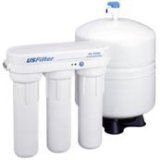With all of the recent publicity that chromium has gotten as a result of EWG Reports Finding Chromium in Municipal Water Systems, we figured some of you might want to know a bit more about the health effects of chromium, where chromium comes from, how to test for chromium in drinking water, and most importantly… how to get rid of chromium if detected in one’s drinking water.
- Chromium will appear in nature in one of three forms: Chromium(0), Chromium(III) or Chromium(VI).
- Chromium(0) gets used in the production of steel.
- Chromium(III) and/or Chromium(VI) may appear in compounds used for chrome plating, making dyes and pigments, tanning leather, and preserving wood.
- Chromium(III) aids the human body in its use of sugar, protein and fat, though health officials suggest not using excessive amounts of dietary supplements containing chromium compounds.
- Higher levels of chromium(VI) may cause irritation to the lining of the nose, ulcers in the nose, runny nose, and other breathing problems such as asthma, coughing, shortness of breath, and/or wheezing. While both Chromium(III) and Chromium(VI) in air can cause the aforementioned problems, effects occur at much lower concentrations of Chromium(VI) than Chromium(III).
- Chromium(III) and Chromium(VI) may exist in drinking water and have no associated tastes or odors.
- If ingested, Chromium(III) compounds tend to have less toxic tendencies and appear to cause fewer health problems than Chromium(VI) which causes anemia, irritation of the stomach, ulcers in the stomach, and ulcers in the small intestine.
- Some laboratory animals exposed to Chromium(VI) experienced sperm damage and damage to the male reproductive system.
- Some Chromium(VI) compounds may cause skin ulcers and a percentage of the population have extreme sensitivity to Chromium(VI) and/or Chromium(III) with allergic reactions manifesting themselves as severe redness and swelling of the skin.
- The Department of Health and Human Services (DHHS), the International Agency for Research on Cancer (IARC), and the EPA have determined that Chromium(VI) compounds are known human carcinogens. ( source )
- Some developmental effects have been observed in animals exposed to Chromium(VI). ( source )
Regulations, rules and recommendations pertaining to Chromium?
The EPA has determined that exposure to chromium in drinking water at concentrations of 1 mg/L for up to 10 days is not expected to cause any adverse effects in a child. The FDA has determined that the chromium concentration in bottled drinking water should not exceed 1 mg/L. The Occupational Health and Safety Administration (OSHA) has limited workers’ exposure to an average of 0.0005 mg/m3 chromium(VI), 0.5 mg/m3 chromium(III), and 1.0 mg/m3 chromium(0) for an 8-hour workday, 40-hour workweek. ( source )
What NSF/ANSI Standards apply to chromium in drinking water?
Standard 53, Standard 58, and Standard 62.
For more information on the specifics of those NSF/ANSI Standards and others, take a look at the NSF International Web Site. It offers a wealth of information for both the consumer AND water professionals alike.
|
|
Removing chromium from drinking water?
As far as units for the average consumer, pretty much only reverse osmosis makes any sense. One could use a process like distillation, but it has a flow rate that most likely would not meet homeowner needs and a much higher entry cost.
As an example of a reverse osmosis that carries NSF Certification for chromium reduction, you may want to take a look at the Pentek RO-3500 which has a price tag of under $270 and appears to offer a lot of filtering power for the money.
Pentek RO-3500 Reverse Osmosis Water Filters have tested and certified to NSF/ANSI Standard 58 for the reduction of Pentavalent Arsenic (Arsenic V), Barium, Cadmium, Copper, Hexavalent & Trivalent Chromium (Chromium VI & Chromium III), Cyst, Fluoride, Lead, Nitrate/Nitrite, Radium 226/228, Selenium, TDS and Turbidity.





